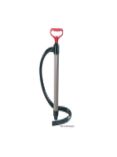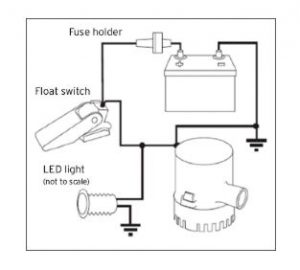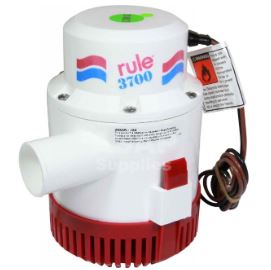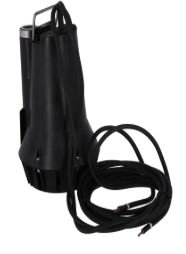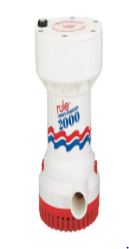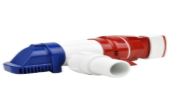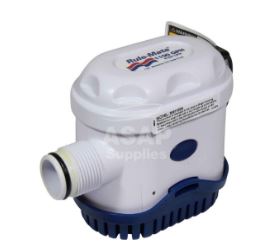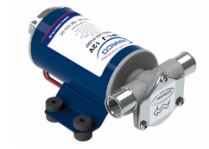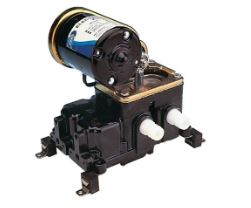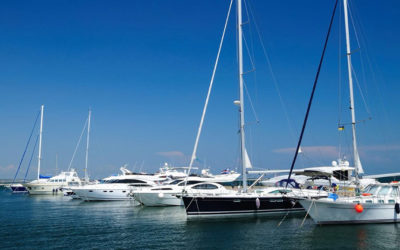In theory, modern bilge pumps make it possible to keep the vessel afloat in the event of a leak. They also allow for small quantities of water to be removed from the bilge.
Although the presence of a “manual bilge pumping device” is mandatory, it is generally not sufficient in the event of significant water ingress. For this reason, pleasure craft generally have modern, electric bilge pumps (12V or 24V DC).
These bilge pumps may have manual or automatic (cyclical) switches, or they may be activated by a float switch. They can be installed permanently, or you can have a mobile model that can be placed as close as possible to the water ingress point.
A hull leak just 150 mm (6 inches) in diameter will allow more than 30 m3 (30,000 liters) of water on board per hour. That is an enormous volume of water, and it can be removed only by a suitable pumping system.
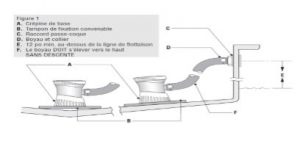
To ensure the best possible performance from your bilge pump(s) in the event of an emergency, there are a number of important factors to consider:
- Limit the length of the pressure and suction lines. (The pipes exert significant resistance – friction – so the farther the device needs to pump, the lower its output will be.)
Ideally, the distance between the pump and the through-full should be no greater than 1 meter. - Try to limit the pump’s exertion by choosing the correct discharge pipe size (26 mm for a medium-sized pump and 36 mm for a high-capacity pump).
- Always install a single pump per discharge line. Two pumps installed on the same line will not work any better than one pump on its own.
- Clean the bilge on a regular basis, removing any debris that could block a switch or damage a pump
- Test your bilge pump(s) periodically.
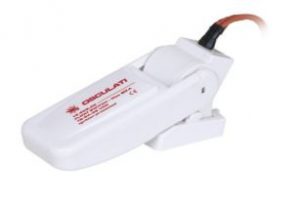
Summary
1. Manual Bilge Pumps
Manual bilge pumps require continuous muscle strength provided by a crew member in order to work. The crew member who is pumping will not be available to seal off the leak 6,000 l/h.
Whale Titan Manual Pump
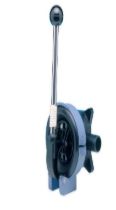
A mobile pump with output around 2,000 l/h, capable of removing water from a 3 cm diameter leak. Plastimo Hand Pump
2. Electric Bilge Pumps
Some electric bilge pumps are submersible, while others operate remotely. Submersible pumps have shorter pipes and, as a result, greater discharge capacity.
Remote pumps offer lower discharge capacity (due to the resistance of the suction pipes). However, the strainer (at the end of the suction pipe) can be maneuvered into the depths of the most cramped hold.
In general, attached submersible bilge pumps with an external contactor are the most powerful pumps available.
Triggered by a switch or contactor, they can pump up to 14,000 l/h. Installing two such pumps, each one with its own discharge through-hull serious increases the likelihood than an offshore cruiser can counteract a severe leak, as long as the vessel’s electrical system remains operational.
A good alternative to the fixed installation of a second bilge pump (and the second through-hull to go with it) is to have a powerful, submersible, mobile electric bilge pump on board, with a capacity of up to 10,000 l/h.
Gianneschi Maxi Sub
Automatic submersible bilge pumps work without a contactor, following an unending cycle, starting up for one second every two minutes. If water is present, the pump will continue to work until the next reset. While these electronic systems function without a contactor, the pump motors undergo considerably more strain than on models with contactors. 7,500 l/h.
Rule RL053
These same models are also available in a more compact size (less than 21 mm high) for small boats with shallow bilges. Be aware, however, that its output capacity is lower, at 3,400 l/h.
Rule LoPro
On immersible bilge pumps with a built-in trigger systems, the casing holds a float switch that triggers the pump when the water reaches a certain level. These are compact, medium-power systems (4,000 l/h).
Here you’ll find the Rule RM 1100.
These remote bilge pumps, featuring a bronze body and flexible rotor, can remove hydrocarbon-laden water or ballast water with their filters, which can fit into any spot, even in otherwise inaccessible places.
Here you’ll find the Marco UP1, which pumps at a rate of 5,000 l/h.
Remote diaphragm bilge pumps run dry without being submersed, but only siphon clean water.
Here you’ll find the Jabsco 33600, which pumps at a rate of 2,000 l/h.
Keep your bilge clear at all times so that you can rely on your bilge pump to work effectively when it counts.
After all, it would be an awful shame if a piece of debris blocked the pump at a crucial moment, causing your boat to sink!
